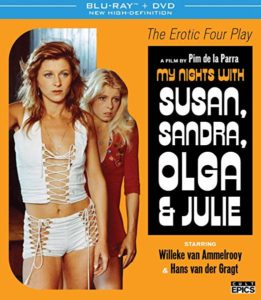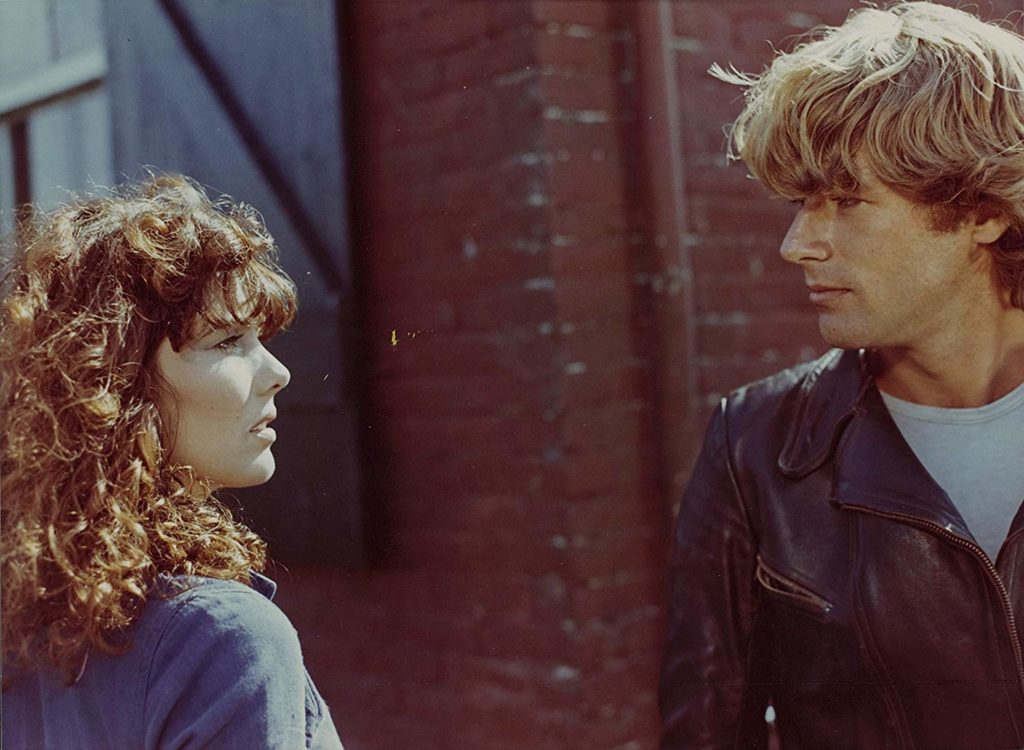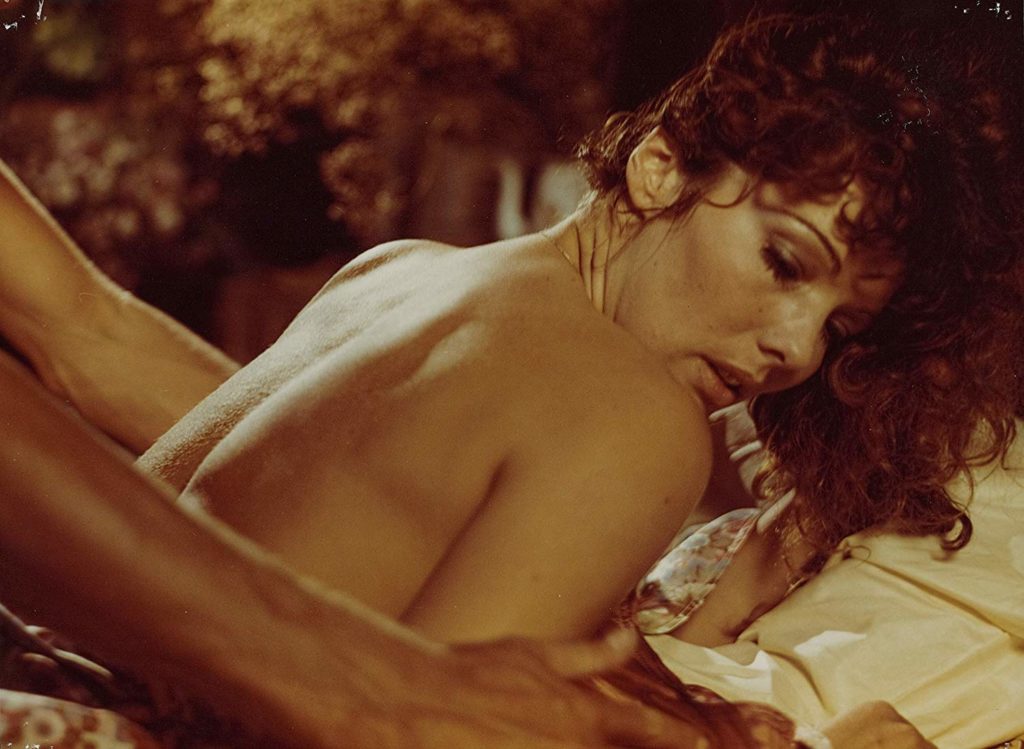1970’s Dutch Cinema Settles in for Some Beautiful Daytime Horror.
DIRECTED BY PIM DE LA PARRA/DUTCH/1975
BLU-RAY STREET DATE: JUNE 11, 2019/CULT EPICS

Sexually speaking, 1975 is a year blissfully unburdened by the grotesque near-future of AIDS and the like. In certain sectors the world over, the “free love” of the late 1960s had by then settled into something of a norm. Dire consequences for reckless intimacy, among other things, lie just around the corner.
Though no one could know that yet, Pim de la Perra’s early 1975 release My Nights with Susan, Sandra, Olga & Julie (shortened, believe it or not, from “My Nights with Susan, Olga, Albert, Julie, Piet & Sandra”), via its closely-woven connections of sex, isolation, and death seems to be tapping into that future. Does the blue-sky-and-sunny My Nights know something prophetic that even its makers and participants couldn’t have known…?
No matter when we watch it, the movie comes at us like like some sort of sexual promise, only to club us upside the head with deranged strangeness, secrets, and never-explained behaviors- all, incongruously, playing out in harsh daylight (despite “Night” appearing prominently in the film’s title).
Less interested in the gritty visual aesthetic that the filmmaker’s game-changing Scorpio Films (aka “$corpio Films”) exuded in previous hits Blue Movie and Frank & Eva, My Nights is, quite ironically, the most conventionally attractive of the bunch. Here, Pim de la Parra gets to explore the rural landscape, breaking free of the enclosures that so fascinated his Scorpio partner and fellow filmmaker, Wim Verstappen with Blue Movie, and contained his own titular characters in Frank & Eva. Whereas Frank & Eva is an urban, vertical movie, this one is wholly horizontal. Shot in techniscope, a kind of poor man’s version of the wide, grandeur-inducing Cinemascope, My Nights wrings every last bead of sweat from its Z-axis-loving frame.
Susan (Willeke van Ammelrooy) is a utilitarian handywoman content to burden herself with all the work of running and maintaining this odd commune of maladjusted young women. In this film, as de la Parra says he jokingly told van Ammelrooy when he recruited her, she doesn’t have to be naked the whole time (compared to her part in Frank & Eva). By contrast, she spends most of her screen time in work clothes, keeping busy with the mundane and occasional repair following someone else’s violent outburst.

When studly young Anton (Hans van der Gragt, looking like something of a forerunner for John Schnieder in The Dukes of Hazzard) arrives on his motorbike to Susan’s communal country home, he meets its attractive young occupants, Olga (Franulka Heyermans), Sandra (Marja de Heer), and Julie (Marieke van Leeuwen). The former two are lovers and closet psychotics who troll around the house nude and occasional kill whomever they’ve lured with their charms.
The naive and innocent Julie basically only ever sleeps, though she also has a genuine love for Albert (Serge-Henri Valcke), a young man who, for reasons unknown, chooses to live in a centralized empty room, lit only with a red, hanging novelty bulb. Not that the rest of the living quarters is all that soothing. The idyllic communal farmhouse’s quaint tranquility is betrayed by its bright burning glossy, primary paint. Though there’s an immediate bond between Susan and Anton, she tells him he’s free to do as he pleases at her house. So, in true 1975 fashion, he gets around to doing just about everybody. But it’s Susan he clearly cares for the most.
In the beginning, skimpy-dressed Sandra and Olga take to strutting seductively up an isolated country road when they spot a wealthy American driver (Jerry Brouer) headed their way. The man of course offers them a ride; they then offer his something more.
“…And then the killing happened.”
The scenes that can be started with that sentence aren’t necessary unexpected in their murderous turn of events, if no less macabre. It’s true, people die in this movie. And, they die arbitrary, anonymous deaths- their only chance of dignified vindication a wild-eyed local wild card, Piet (Nelly Frijda).
Moments later, the joyriding man would meet his ultimate reward while in the passion of his temporary one. Why do Sandra and Olga murder the American? After dragging his body into the nearest shallow creek (and not even bothering to submerge it), leaving his very nice convertible behind. No one even bothers to close its door, not even Piet, who saw it all from behind some tall grass.
When the diabolical Sandra and Olga corner Piet, cruelly painting her face with the think paintbrush and stain she’s carrying (left there by busybody Susan), both the moment and the immediate aftermath (Piet running, terrorized, across a barren field to the nearest pond, its own surface aggressively swarming with insects) are played- and scored- as a horror film.
Though de la Perra was noticeably influenced by Hitchcock’s work, My Nights is far less a suspense picture nor a psychological thriller so much as it is truly horror, if a bit stealth in its approach. This is something of a twisted horror film, at that; one that refuses to explain itself and will not be resolved. Not conventionally, anyhow. When viewed through this lens, the lens of the uneasily uncanny, My Nights comes into focus most acutely.
It true that it’s horror-based in a now-questionable basis of multiple characters suffering varying degrees of mental illness, but still, one suspects that this unrestrained level of onscreen deviance, death and untethered logic is something that Hitchcock himself wanted to put forth at some point but couldn’t. The layers stack up thusly: Selectively clad girls commit murder with blunt, glass objects while in the throes of intercourse. An earringed young male (the mysterious Albert), often seen only in closeup profile, sees it all. And in the know about all of it comes the wandering Piet, who’s repeatedly harassed by the vulgar taunts of Olga and Sandra.
Through Piet’s actions, Anton realizes that death has in fact descended upon their remote corner of the world. But then, he has the most difficult time trying to make Susan face the gruesome truth of what’s happening. She proves staunchly dense, clinging to her reality of routine and continuous doing. At one point, when she smacks him, he smacks right back, without missing a beat. Frustration. The only ostensibly sane people seem to be losing it one another. Waking up is hard to do.
Later, the open-eyed unblinking corpses of the victims will stare into fiery, lonesome vengeance.

If there’s any doubt of the film’s intended tone and genre, the full, original orchestral score by English composer Elisabeth Lutyens will leave little doubt. Doing her best Bernard Herrmann, Lutyens was actually recommended by said elder composer when he declared himself out of Scorpio’s price range. This would prove to be Lutyens final film composing job.
According to Pim de la Parra’s new and forthright optional video introduction, this was the final Scorpio Films production in which the company was financially solvent enough to pay everyone involved in its making. Following this film, he would go bankrupt on the production of his next one.
The director concludes his new introductory address by reminding us that this is “a small movie from a small country”, just before being unable to resist adding, “and I’m also a very small man, as you can see!” While not exactly the info-filled feature-length commentary he provided for Cult Epics’ Frank & Eva disc, it’s good to see the filmmaker happily participating in some way.
In Dutch with English subtitles, this forever-1970’s curio looks and sounds astonishingly well on Blu-ray. Cult Epics has done another commendable job in serving up a rare nugget of cinema history in fine form, for fans of such things. Primary bonus features are three of Scorpio’s early short films, each running about ten minutes in length. Generally comedic in tone, these amusing efforts reveal a certain Godardian influence, reinforcing the hints of that very thing in My Nights with Susan, Sandra, Olga & Julie. For those who feel the need to have both high and low definition bases covered, a DVD of the film is included as well.
Of the three Scorpio Films I’ve covered thus far; this one manages to be both the most and least accessible. My Nights is a strange piece to be sure, but like Susan’s doom-ridden “free youth hostel” (as Anton calls it), it has a way of luring you to stay… until the bitter end.

